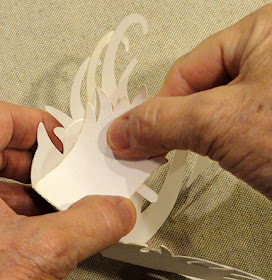Simple
“square” footprint belies the complex
visual interest conveyed by this
interesting container
composed of lid and base.
One-piece cut shapes are
embellished with rounded
corner offset accent shapes to mix and match.
Create
an alternate version by stacking scalloped circles
for a platform – then add
plain circle accent.
Box is designed as companion container to act as
pedestal
for the “Box Swan 3D Tray” for
a show-stopping ensemble for Twelve Days of Christmas
giving (or other worthy occasion!).
Box top or bottom panel measures approx.
2.25” square;
center perimeter measures approx. 3.25” square;
container height
measures approx. 3.625”.
ASSEMBLY: 1. Identify and cut the shapes:
A lid main shape
B lid top accent square
C lid large triangle accents (4)
D lid isosc triangle accents (4)
E lid inner reinforcement frame
F optional scalloped circle platform top (1 shown red)
and interior (2-3 shown beige)
G optional scalloped circle bottom with registration
square window cut out
H base main shape
I base floor reinforcement square (2)
J base isosc triangle accents (4)
K base large triangle accents (3)
ALL perforations for square top panel, side triangle
with narrow offset margin all around, centering it
within the square space defined by perforation lines.
Also position and attach the lid accent triangles
and isosceles triangles within their respective panels
to bring straight edge of one to overlap the adjacent
tab flange edge to perforation line, and glue in place.
overlap straight edge across tab to perf line,
and glue in place.
6. Repeat steps 4-5 for remaining 3 seams
of the four flanges, then insert the frame into the lid
crease fits snugly into the corners where angled
the inside surface of the lid until each is secure.
9. Begin base assembly by bending on perforation lines
9. Begin base assembly by bending on perforation lines
in manner similar to lid as shown in step 2.
Stack and glue together the optional base bottom
reinforcement squares.
onto the inside bottom panel, within the area
defined by the perforation lines. Press the entire assembly
under a heavy flat weight until glue dries.
11. Follow the second half of step 3 to position and attach
the accent triangles onto their respective panels with
the accent triangles onto their respective panels with
narrow offset margins all around.
NOTE that the base main shape has small
semi-circle "bites" in the long flanges
as a means of identifying it as base.
end seams to complete the base dome.
13. To close the box, fit the lid rim over the base rim
and gently push together until the base rim
stops when it touches the lid's interior
reinforcement frame structure. NOTE that the two
the interior and top (whole) platform scalloped circle
shapes one by one, taking care to rotate for
precise scalloped edges alignment, until all
outer cut edges rotated for precise alignment.
Press the stack under a flat heavy object such as
a thick book (possibly with something else heavy
on top) until the glue is completely dry, to avoid
curling or warping of the glued-up stack.
if using exclusively with the angled sides box.
within the square alignment area, then position on top
of the lid, with lid top panel fitting within square window.
(When the circles platform is used, the box's top square
accent shape can be eliminated.)
17. If pairing the angled sides box with the swan tray
for a combination project, replace the whole accent
circle with the triangle platform/circle assembly,
to position and attach it to scalloped circles stack.
Then, once the circle platform assembly is attached
to top of box's lid, position and attach the swan
to the triangle riser, and proceed with embellishment
and other decoration . . .




















































